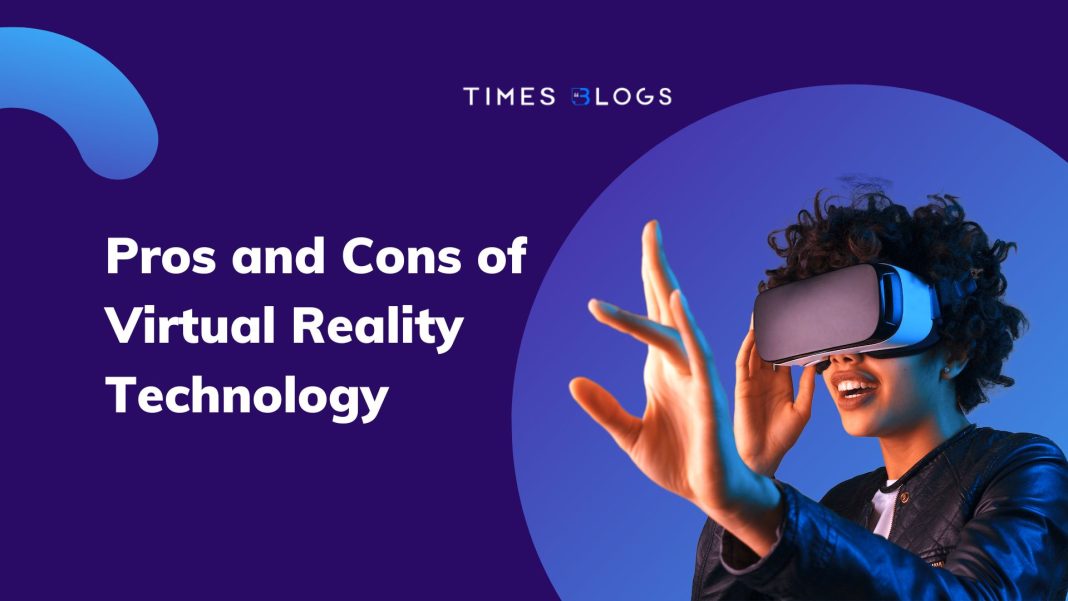Virtual Reality (VR) technology has been around for a few decades, but it’s only in recent years that it has become accessible to the general public. VR allows users to experience a completely different world that is either entirely imaginary or based on reality. This technology has revolutionized the gaming industry and is being utilized in various other industries as well, including education, healthcare, and entertainment. While there are many advantages of using virtual reality, there are also some drawbacks that must be considered. In this blog, we will discuss the pros and cons of virtual reality technology.
What is Virtual Reality (VR)?
Virtual Reality (VR) is a computer-generated simulation of an environment that can be experienced by a user as if they are actually present in that environment. VR typically involves the use of a head-mounted display (HMD) that covers the user’s eyes and displays a 3D environment that responds to the user’s movements. The user can interact with the virtual environment using controllers, gestures, or other input devices, and the VR system will respond accordingly.
VR technology can be used in various fields, including entertainment, education, healthcare, and gaming, to provide an immersive and interactive experience for users. The technology has evolved rapidly in recent years, and modern VR systems can provide high-quality graphics, realistic audio, and advanced tracking systems to create a truly immersive experience for users.
Pros of Virtual Reality Technology
- Immersive Experience
One of the most significant advantages of virtual reality technology is the immersive experience that it provides. VR technology can transport users to a completely different world that feels entirely real. The user can interact with the environment, objects, and other virtual characters as if they were in the physical world. This immersive experience can be beneficial in various fields, including education, healthcare, and entertainment.
- Enhances Learning Experience
Virtual reality technology can enhance the learning experience by providing a more engaging and interactive environment. VR can recreate historical events, scientific concepts, and other educational topics, making them more accessible and easier to understand. For example, medical students can use VR to practice surgeries, which can be a safer and more efficient way of learning.
- Cost-effective
Virtual reality technology can be cost-effective in many industries. For example, in the aviation industry, pilots can use VR to simulate various scenarios, which can be much cheaper than using real aircraft. VR can also be used in various other industries, such as construction, where it can simulate different construction scenarios, saving time and resources.
- Provides Entertainment
Virtual reality technology has revolutionized the entertainment industry. VR games provide a completely different level of immersion and interactivity, making gaming experiences more enjoyable. VR technology can also provide users with a more immersive cinematic experience.
- Medical Benefits
Virtual reality technology has been proven to have various medical benefits. It can be used to treat mental health issues such as anxiety disorders, phobias, and post-traumatic stress disorder (PTSD). It can also be used for physical rehabilitation, such as helping stroke patients regain their motor skills.
Cons of Virtual Reality Technology
- Expensive
One of the main drawbacks of virtual reality technology is the cost. VR headsets can be expensive, and not everyone can afford them. Additionally, some VR systems require high-end computers or gaming consoles to run, which can add to the overall cost.
- Health Concerns
Virtual reality technology can cause some health concerns, such as motion sickness, eye strain, and headaches. Prolonged use of VR can also cause fatigue, dizziness, and disorientation. It’s essential to take regular breaks when using VR to prevent these health issues.
- Limited Interaction
Although virtual reality technology provides an immersive experience, it still has limited interaction capabilities. Users can interact with the environment and objects to a certain extent, but it’s still not the same as the physical world. This limited interaction can be a drawback in various fields, such as education and healthcare, where hands-on experience is essential.
- Addiction
Virtual reality technology can be addictive, especially in gaming. Users can become so immersed in the virtual world that they neglect their real-life responsibilities and relationships. Addiction to VR can lead to social isolation and other psychological issues.
- Technical Limitations
Virtual reality technology is still relatively new, and there are technical limitations that must be considered. For example, the resolution of VR headsets is not as high as regular monitors, which can affect the visual quality. Additionally, the tracking of the user’s movement can be inaccurate, leading to motion sickness and other health concerns.
The Future of Virtual Reality (VR)
The future of virtual reality (VR) technology is bright, with many advancements and developments expected in the coming years. VR is already being used in various fields, including entertainment, education, healthcare, and gaming, but there are many more areas where VR could have a significant impact.
One area where VR is expected to make significant progress is in the field of education. VR can provide students with immersive learning experiences that are more engaging and memorable than traditional classroom teaching methods. For example, students can use VR to explore historical sites, examine scientific phenomena, or experience different cultures, all without leaving the classroom. As VR technology becomes more accessible, we can expect to see more schools and educational institutions incorporating VR into their curriculums.
In the entertainment industry, VR is expected to play a significant role in the future of gaming and other forms of media. VR technology allows players to fully immerse themselves in a game or movie, providing a more realistic and interactive experience. As VR technology continues to advance, we can expect to see more games and movies being developed specifically for VR platforms.
Another area where VR is expected to make significant progress is in the field of healthcare. VR can be used to treat a range of medical conditions, including mental health issues, chronic pain, and physical rehabilitation. For example, patients with anxiety disorders can use VR to simulate exposure therapy in a safe and controlled environment. Additionally, VR can provide physical therapy patients with a more engaging and interactive rehabilitation experience.
In the business world, VR is expected to become increasingly important in areas such as training and remote collaboration. VR can be used to provide employees with hands-on training in a safe and controlled environment, reducing the risk of accidents and mistakes. Additionally, VR can be used to facilitate remote collaboration between teams, allowing team members in different locations to work together in a shared virtual space.
Conclusion
Virtual reality technology has numerous advantages and disadvantages that must be considered when utilizing it in various fields. The immersive experience provided by VR can be beneficial in education, healthcare, and entertainment. It can also be cost-effective in some industries, such as aviation and construction. VR technology has various medical benefits, such as treating mental health issues and physical rehabilitation.
However, there are also some drawbacks to virtual reality technology that must be taken into account. The cost of VR headsets can be a barrier for some people, and prolonged use of VR can cause health concerns such as motion sickness and eye strain. The limited interaction capabilities of VR can be a drawback in fields where hands-on experience is essential, and addiction to VR can lead to social isolation and other psychological issues. Additionally, technical limitations such as low resolution and inaccurate tracking can affect the quality of the VR experience.
Overall, virtual reality technology has the potential to revolutionize various industries, but it’s essential to weigh its pros and cons before utilizing it. As technology continues to advance, we can expect virtual reality technology to become even more accessible and provide even more benefits. However, we must also be aware of its limitations and work to address them as VR becomes more prevalent in our lives.




